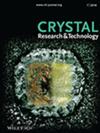First‐Principles Molecular Dynamics Study of the Threshold Displacement Energy in LiFe5O8
IF 1.9
4区 材料科学
Q3 CRYSTALLOGRAPHY
引用次数: 0
Abstract
The threshold displacement energies (TDEs) of lattice atoms in lithium ferrite (LiFe5O8) are calculated using first‐principles molecular dynamics simulations. The TDEs vary with crystal direction and sublattice. The weighted average TDEs are 34.65, 28.54, 38.85, 37.92, and 34.31 eV for FeTetra, FeOct, Li, OI, and OII atoms in LiFe5O8, respectively. The FeOct primary knock‐on atom (PKA) has the smallest TDE. Various defects, including vacancies ( VFeTetra , VFeOct , VLi , VOI , and VOII ), interstitials (IFe, ILi and IO), antisite defects ( LiFeOct , LiFeTetra and FeLi ), split interstitials ( DFeFe , DLiLi , DLiFe , and DOO ), crowding defects (CrowFeFeFe) and exchange defects (OO), are formed by low‐energy recoil events. The effect of the presence of these defects on the magnetic behavior in LFO is investigated using density functional theory. The occupation of the octahedral and tetrahedral sublattice in LiFe5O8 has an important effect on magnetization. The net magnetization decreases or increases when a Fe atom at an octahedral or tetrahedral site is replaced by a nonmagnetic atom, respectively. These results are helpful for using irradiation to tune the magnetic behavior of LiFe5O8 and applying magnetic devices based on LiFe5O8 in the presence of irradiation.LiFe5O8中阈值位移能的第一性原理分子动力学研究
利用第一性原理分子动力学模拟计算了铁酸锂(LiFe5O8)晶格原子的阈值位移能(TDEs)。tde随晶体方向和亚晶格的变化而变化。LiFe5O8中FeTetra、FeOct、Li、OI和OII原子的加权平均tde分别为34.65、28.54、38.85、37.92和34.31 eV。FeOct主敲原子(PKA)的TDE最小。各种缺陷,包括空位(VFeTetra、VFeOct、VLi、VOI和VOII)、间隙(IFe、ILi和IO)、反位缺陷(LiFeOct、LiFeTetra和FeLi)、分裂间隙(DFeFe、DLiLi、DLiFe和DOO)、拥挤缺陷(CrowFeFeFe)和交换缺陷(OO),都是由低能反冲事件形成的。利用密度泛函理论研究了这些缺陷的存在对LFO磁性行为的影响。LiFe5O8中八面体和四面体亚晶格的占位对磁化性能有重要影响。当八面体或四面体位置的铁原子分别被非磁性原子取代时,净磁化强度降低或增加。这些结果有助于利用辐照调节LiFe5O8的磁性行为,以及在辐照下应用基于LiFe5O8的磁性器件。
本文章由计算机程序翻译,如有差异,请以英文原文为准。
求助全文
约1分钟内获得全文
求助全文
来源期刊
自引率
6.70%
发文量
121
审稿时长
1.9 months
期刊介绍:
The journal Crystal Research and Technology is a pure online Journal (since 2012).
Crystal Research and Technology is an international journal examining all aspects of research within experimental, industrial, and theoretical crystallography. The journal covers the relevant aspects of
-crystal growth techniques and phenomena (including bulk growth, thin films)
-modern crystalline materials (e.g. smart materials, nanocrystals, quasicrystals, liquid crystals)
-industrial crystallisation
-application of crystals in materials science, electronics, data storage, and optics
-experimental, simulation and theoretical studies of the structural properties of crystals
-crystallographic computing

 求助内容:
求助内容: 应助结果提醒方式:
应助结果提醒方式:


